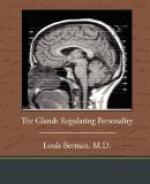Giants and dwarfs and fat people have always interested people as freaks, departures from the usual and the normal, and have formed the stock of popular museum, circus and country fair. Every mythology has concerned itself with them. The Titans among the Greeks, Og, Gog and Magog among the Hebrews, are examples of the fascination of the superlarge. John Hunter, the founder of experimental surgery, spent a fortune in chasing after the skeleton of a famous Irish Giant in 1783. Dwarfs have also fascinated—witness the short-limbed satyrs of the Greeks and the dwarf gods (Ptah and Bes) of Egypt, as well as the vogue of the court dwarf-buffoons, of whom Velasquez has left us some portraits. Fat people, obesity as a manifestation of personality, have aroused wonder and amusement the world over. The Fat Boy has always furnished good sport to the Sam Wellers.
All these characters, tall or short, fat or lean, are related to the activity of a gland of internal secretion in the head, the pituitary, which became a centre of interest in the late eighties. Because of its situation, the opinion of the ancients was that it was the source of the mucus of the nose, an opinion reinforced by the greatest anatomist of the Dark Ages, Galen, and held up to the seventeenth century. In other words, it was considered simply a gland of external secretion. Experimental removal of the pituitary was essayed by Horsley in 1886, the same man who two years before had reproduced myxedema successfully in monkeys. Others succeeded his attempt. But the conclusions drawn were uncertain or contradictory, resulting from the difficulties of the operative technique of getting at a gland placed at the base of the brain. Not until 1908 was the problem solved by Paulesco of Bucharest, who devised a way of reaching it by trepanning the skull. He was thus able to prove beyond a doubt that the pituitary gland was essential to life, and that without it no animal could continue to live for any length of time. Soon after, Harvey Gushing and his associates at Johns Hopkins Hospital discovered that removal of part of the gland was followed by a pronounced obesity and sluggishness. A basis for the understanding of obesity and growth was then established.




